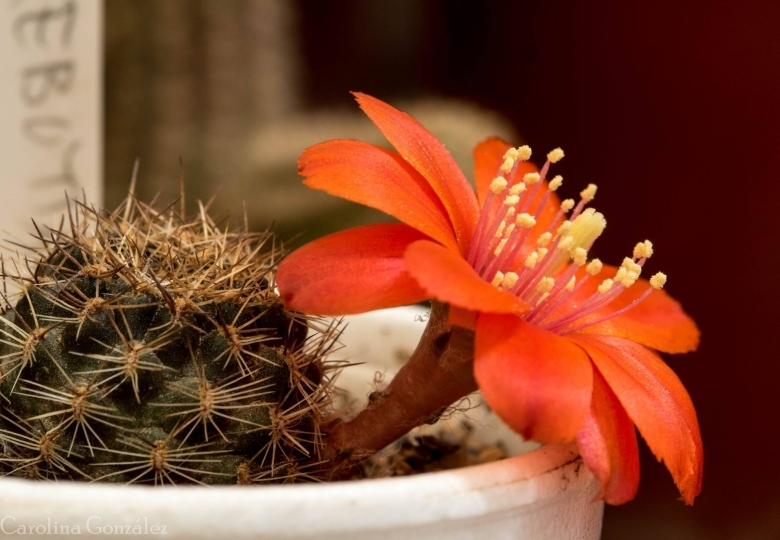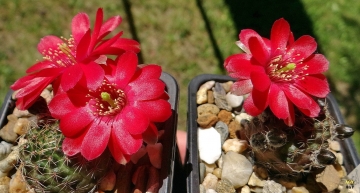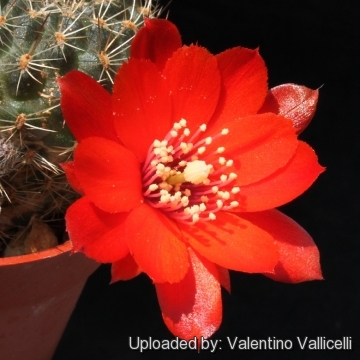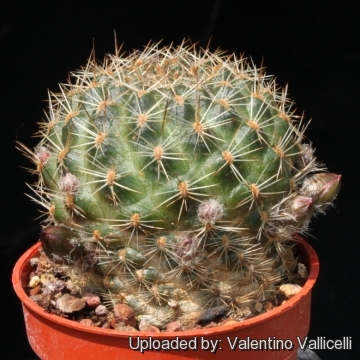= Rebutia brunescens Rausch
Kakteen Sukk. 23: 235, 1972 / K. u. a. S. 23, 9 235-236, 1972
Accepted Scientific Name: Rebutia ritteri (Wessner) Buining & Donald
Sukkulentenkunde 7/8: 103 103 1963

Mediolobivia atrovirens var. brunescens (Rebutia brunescens) Photo by: Carolina González
Origin and Habitat: Chuquisaca, dep. Potosí, Bolivia (South America).
Synonyms:
See all synonyms of Rebutia ritteri
back
Accepted name in llifle Database:Rebutia ritteri (Wessner) Buining & DonaldSukkulentenkunde 7/8: 103 103 1963Synonymy: 18
back
Description: Rebutia brunescensSN|25492]]SN|15750]], is a local or morphological form of the variable Rebutia ritteriSN|25492]]SN|25492]]. It distinguishes from the latter for the slightly larger stem, brown spines and large fiery vermilion blooms. The differences with Rebutia ritteriSN|25492]]SN|25492]] are in reality very minimal and most botanist agree on the fact that both should all be included in the Rebutia ritteriSN|15750]]SN|25492]], and the two plants are not readily distinguishable, if not for the geographical provenance.
Habit: It is an attractive dwarf clustering, cactus covered with characteristic short brownish spines and light green tubercles barely covering the body. It is a free-flowering species, but quite variable.
Stems: Roundish to slightly elongated, depressed at the top, grey-green, to 5 cm high and 3,5 cm in diameter covered by distinctive conical tubercles with hexagonal bases similar to a Mammillaria, that are easy to see through the small spines.
Ribs: Up to 18, forming distinct tubercles.
Areoles: Rather large, elliptical, brownish-tomentose.
Spines: 8-10, erect, fine, needle-like, all more or less similar, brownish, to 1 cm long.
Flowers: Flowers produced halfway up the stems, curving upward,flame coloured to crimson, throats reddish violet, to 4 cm long and 4,5 cm in diameter. Tube narrow.
Blooming season: Flowers all tend to come in one late Spring rush, rather than spread over the Summer, and remain open for up to six days.
Fruits: Tiny, spherical, berrylike, brownish to olive green.
Subspecies, varieties, forms and cultivars of plants belonging to the Rebutia ritteri group
 Rebutia brunescens Rausch: has slightly larger stem, brown spines and fiery vermilion blooms. The differences with Rebutia ritteri are in reality very minimal. Distribution: Chuquisaca, dep. Potosí, Bolivia.
Rebutia brunescens Rausch: has slightly larger stem, brown spines and fiery vermilion blooms. The differences with Rebutia ritteri are in reality very minimal. Distribution: Chuquisaca, dep. Potosí, Bolivia.- Rebutia ritteri (Wessner) Buining & Donald: has short spines and flame coloured to crimson flowers; throats reddish violet . Distribution: Salta and Jujuy (Argentina) and Chuquisaca, Potosí and Tarija (Bolivia).
Bibliography: Major references and further lectures
1) James Cullen, Sabina G. Knees, H. Suzanne Cubey “The European Garden Flora Flowering Plants: A Manual for the Identification of Plants Cultivated in Europe, Both Out-of-Doors and Under Glass” Cambridge University Press, 11/Aug./2011
2) David Hunt, Nigel Taylor “The New Cactus Lexicon” DH Books, 2006
3) Edward F. Anderson “The Cactus Family” Timber Press, 2001
4) Anderson E. F.: "The Cactus Family" Timber Press, Portland, Oregon, 2001
5) Ritter Fr.: "Kakteen in Südamerika" Spangenberg, 1980
6) Lowry, M. 2013. Rebutia ritteri. In: IUCN 2013."IUCN Red List of Threatened Species." Version 2013.1. <www.iucnredlist.org>. Downloaded on 15 October 2013.
 - RH871 (Collector Ralf Hillmann) Locality: Huari-Huari, Potosí, Bolivia, 3950m at: Rebutialand - Cactus collection - Hungary. (Rebutia brunescens) Photo by: Agócs György
- RH871 (Collector Ralf Hillmann) Locality: Huari-Huari, Potosí, Bolivia, 3950m at: Rebutialand - Cactus collection - Hungary. (Rebutia brunescens) Photo by: Agócs György Mediolobivia atrovirens var. brunescens (Rebutia brunescens) Photo by: Valentino Vallicelli
Mediolobivia atrovirens var. brunescens (Rebutia brunescens) Photo by: Valentino Vallicelli Mediolobivia atrovirens var. brunescens (Rebutia brunescens) Photo by: Carolina González
Mediolobivia atrovirens var. brunescens (Rebutia brunescens) Photo by: Carolina González Mediolobivia atrovirens var. brunescens (Rebutia brunescens) Photo by: Valentino Vallicelli
Mediolobivia atrovirens var. brunescens (Rebutia brunescens) Photo by: Valentino Vallicelli Mediolobivia atrovirens var. brunescens (Rebutia brunescens) Photo by: Valentino Vallicelli
Mediolobivia atrovirens var. brunescens (Rebutia brunescens) Photo by: Valentino VallicelliSend a photo of this plant.The gallery now contains thousands of pictures, however it is possible to do even more. We are, of course, seeking photos of species not yet shown in the gallery but not only that, we are also looking for better pictures than those already present.
Read More... Cultivation and Propagation: Rebutia brunescensSN|25492]]SN|15750]] is a summer grower species that is easy to cultivate and recommended for beginners. The whole Rebutia ritteriSN|15750]]SN|25492]] complex has delightful flowers and the plants remain compact, and clumps can easily be managed by division. Another advantage is that the plants are cold hardy in winter if kept dry.
Growth rate: It is a slow growing but easily flowering species that will make clumps given the best conditions.
Soils: This species is easy to cultivate in a very open mineral mix with at least 50% sand or pumice grit and a pH slightly on the acidic side.
Repotting: It is better that they are repotted regularly. Pots should be only slightly larger than the plant and root system. Repotting will increase the number and size of stems, and will increase the number of flowers produced. Repot yearly until they reach about 100 mm in size, then every two or three years will suffice. Repotting is best done at the end of winter, but can be done at other times, too. Do not water for a couple of weeks after repotting, to reduce risk of root rot via broken roots. A layer of 'pea' gravel at the bottom of the pot improves drainage. A layer of decorative gravel as a top dressing helps prevent the caking of the potting mix, which decreases the rate of water absorption. It also keeps the perlite and pumice from blowing everywhere, and looks nice.
Watering: It requires full sun or light shade and careful watering to keep plant compact, and maintain strong and dense spines and allow the pot to dry out between waterings. Keep dry in winter at a minimum temperature of 0°C. It tends to rot if too wet. The plants can be placed outdoors in April, but protected from rain and direct sunlight. Water them thoroughly when placed out, and again in two weeks, and again in one week. After one month the plants are ready to be placed out in full sun and full rain for the summer. During dry spells the collection is watered once a week, during hot dry spells, twice a week.
Fertilization: Feed with a high potassium fertilizer in summer.
Hardiness: It is reputedly resistant to frost if kept on the dry side prior to, and during, cold weather and requires a winter rest period (hardy to -7° C, or less for short periods). Rebutias grow in nature at high altitudes, and do not thrive well at high temperatures in cultivation. They will often go dormant in mid-summer, and resume growth again when the weather cools in late August. They can tolerate amazingly low temperatures for long periods of time. All species can take a frost, even when not bone dry. It is generally accepted that plants kept at too high a temperature, or watered too much during the winter rest period, will not bloom the following year. They will be perfectly happy in pots outdoors from April to September if protected from torrential rain and hail.
Exposition: The plant tolerates extremely bright situations but enjoys filtered sunlight or afternoon shade, inside it needs bright light, and some direct sun. Tends to bronze in strong light, which encourages flowering and heavy spine production, but is likely to suffer from sun scorch or stunted growth if over exposed to direct sunlight during the hottest part of the day in summer.
Uses: It is an excellent plant for container growing. It always looks good and stays small. It look fine in a cold greenhouse and frame or outdoor in a rockery.
Pests & diseases: All, especially the young, are susceptible to red spider mites.
Rot: This species is particularly easy and accommodating, seldom suffer of cryptogamic diseases. Rot it is only a minor problem with rebutias if the plants are watered and “aired” correctly. If they are not, fungicides won't help all that much.
Propagation: Offsets, seeds. Seeds germinate in 7-14 days at 21-27° C in spring, remove gradually the glass cover as soon the plants will be well rooted (ca 1-2 weeks) and keep ventilated, no full sun for young plants! To make a cutting twist off a branch and permit it to dry out a couple of weeks, lay it on the soil and insert the stem end partially into the soil. Try to keep the cutting somewhat upright so that the roots are able to grow downward.
Note: It would appear that in cultivation they grow larger and cluster more vigorously than in habitat.















